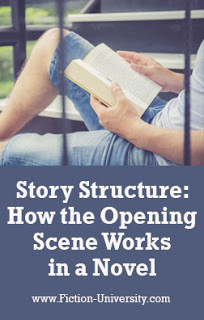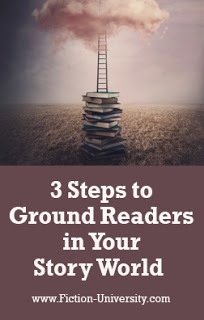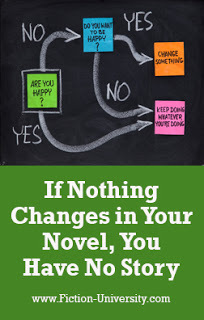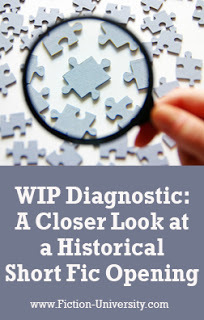Janice Hardy's Blog, page 30
February 6, 2021
WIP Diagnostic: Is This Working? A Closer Look at Building Tension in a Scene
 Critique By Janice Hardy, @Janice_Hardy
Critique By Janice Hardy, @Janice_HardyWIP Diagnostics is a weekly column that studies a snippet of a work in progress for specific issues. Readers are encouraged to send in work with questions, and we diagnose it on the site. It’s part critique, part example, and designed to help the submitter as well as anyone else having a similar problem.
If you're interested in submitting to WIP Diagnostics, please check out these guidelines.
Submissions currently in the queue: One
Please Note: As of today, critique slots are booked through February 13.
This week’s questions:
1. What does/doesn't work in this scene?
2. Is there a sense of caring/identifying with the character?
3. Is there enough showing instead of telling?
4. Is the hook strong enough?
Market/Genre: Romantic Suspense
On to the diagnosis…
Continue ReadingWritten by Janice Hardy. Fiction-University.com
Published on February 06, 2021 05:10
February 5, 2021
Story Structure: How the Opening Scene Works in a Novel
 By Janice Hardy, @Janice_Hardy
By Janice Hardy, @Janice_Hardy The opening scene is the preview for your entire novel.
I find opening scenes both easy and hard to write. Once I’m ready to write them they’re easy, but it might take me a month or more to figure out the right opening line. And I can’t write the novel until I have the right opening line and scene. I need to start off from the right point or I tend to wander into the weeds.
Other writers don’t have this issue, and write whatever comes to them, knowing they’re going to revise it later. They don’t know what the right opening scene is until they write the final scene.
Both (and everything in between), are perfectly acceptable ways to write opening scenes.
Which is good, because opening scenes need to do a lot. They need to introduce the protagonist, the setting, the hook, the problem, show conflict, create voice, craft intriguing story questions, ground readers, make readers like your characters, and the list goes on and on.
Continue ReadingWritten by Janice Hardy. Fiction-University.com
Published on February 05, 2021 03:00
February 4, 2021
How Do You Write a Great Story? Go Hot, Go Deep
 By Dario Ciriello, @Dario_Ciriello
By Dario Ciriello, @Dario_Ciriello Part of The How They Do It Series
JH: Skimming the surface of your story might work for an early brainstorming session, but it won't get you the novel you really want. Dario Ciriello shares tips on how to dig deeper for a strong novel.
Many years ago, the legendary, multiple award-winning editor of Asimov’s Science Fiction Magazine, Gardner Dozois, was telling my Clarion West class about the magazine’s slushpile. Once you got rid of the garbage, he said, you were left with quite a few publishable stories. The challenge then was finding the one that stood out from all the “not bad” ones, the story that achieved greatness and would resonate with readers. A few years later, when I had my own slushpile for the Panverse series of SFF novella anthologies I edited and published, I discovered he was absolutely right. And in the several years since, working as a freelance editor/copyeditor, I find the same to be true.
Continue ReadingWritten by Janice Hardy. Fiction-University.com
Published on February 04, 2021 03:31
February 3, 2021
3 Steps to Ground Readers in Your Story World
 By Janice Hardy, @Janice_Hardy
By Janice Hardy, @Janice_Hardy Losing readers in the opening scene is a problem many novels face.
Opening scenes lead really stressful lives (metaphorically speaking). They have to hook readers, offer a compelling problem, introduce characters, show voice, and establish the world and setting by the end of the scene. No pressure, right?
I’ve been doing weekly critiques on this site since 2010, and the most common submission I get is the first page. So I’ve seen a lot of openings in a variety of genres and markets. And there’s one mistake I see writers make over and over.
Not grounding readers in the story world.
Grounded readers have the tools they need to embrace—and enjoy—the story.
Ungrounded readers feel lost and confused, and the longer that confusion lasts, the more likely it is they’ll stop reading the book. They’re too busy trying to make sense of what they’re reading to lose themselves in the story. Quite often, they can’t connect to the characters because they can’t get a bead on who they are and what they want.
Continue ReadingWritten by Janice Hardy. Fiction-University.com
Published on February 03, 2021 02:30
February 2, 2021
6 Rules for Retelling Classic Stories
 By Bethany Henry
By Bethany HenryPart of The How They Do It Series
JH: Putting a fresh twist on a classic story brings new life to it. Bethany Henry shares tips on how to retell a classic tale.
Bethany Henry writes fantasy novels and blogs about writing and wellness at bethany-henry.com. When not writing, she can often be found on the frisbee field, drinking tea, or reading picture books with her two little girls. Sign up for her email list for weekly posts on writing craft- along with fun extras like quotes and freebies.
Website | Blog | Facebook | Pinterest | Email List
Take it away Bethany...Continue ReadingWritten by Janice Hardy. Fiction-University.com
Published on February 02, 2021 03:00
February 1, 2021
If Nothing Changes in Your Novel, You Have No Story
 By Janice Hardy, @Janice_Hardy
By Janice Hardy, @Janice_Hardy No matter how exciting a scene might be, if it doesn’t change anything in the story, it’s not doing your novel any good.
If there’s one thing that’s constant in all novels, it’s change. No matter what genre, a character experiences a series of events and things are different by the end of the tale. The more character-focused the novel, the greater and more personal this change is likely to be, but it appears in even the most plot-centric books as well.
A mystery starts off with a victim and ends up with a killer caught and justice served. A thriller starts off with someone in jeopardy and ends up with people saved. A fantasy starts off with a hero facing a quest and ends up with that quest fulfilled.
The “big change” is what the book is ultimately about, but changes exist at every structural level of the novel. Plot events change how characters act, character realizations change how the plot unfolds, information revealed changes how readers and characters see and understand the story itself and the people in it.
Continue ReadingWritten by Janice Hardy. Fiction-University.com
Published on February 01, 2021 03:18
January 30, 2021
WIP Diagnostic: Is This Working? A Closer Look at a Historical Short Story Opening
 Critique By Maria D'Marco
Critique By Maria D'Marco WIP Diagnostics is a weekly column that studies a snippet of a work in progress for specific issues. Readers are encouraged to send in work with questions, and we diagnose it on the site. It’s part critique, part example, and designed to help the submitter as well as anyone else having a similar problem.
If you're interested in submitting to WIP Diagnostics, please check out these guidelines.
Submissions currently in the queue: Zero
Please Note: As of today, critique slots are open.
This week’s question:
Does this opening work?
Market/Genre: Historical Short Story
On to the diagnosis…
Continue ReadingWritten by Janice Hardy. Fiction-University.com
Published on January 30, 2021 04:07
January 29, 2021
What You Should Know About the Three Act Structure
 By Janice Hardy, @Janice_Hardy
By Janice Hardy, @Janice_HardyStory structure is a useful tool for developing and writing a novel.
The first time I learned about story structure, it felt as if the sky had opened and truth crashed down upon my head. There was a format for writing a novel? Why hadn’t anyone told me about this?
I embraced it wholeheartedly, and have spent my writing life learning as much about it as I could. I love structure, and love seeing how different writers use it and adapt it to their processes. I’ve fiddled with mine over the years and improved it, as well as totally mucked it up (these things happen).
My favorite is the classic Three Act Structure. I find it the easiest to use, and the most flexible to adapt to suit a writer’s needs.
Continue ReadingWritten by Janice Hardy. Fiction-University.com
Published on January 29, 2021 02:30
January 28, 2021
3 Quick Building Blocks to Creating Crackling Character Chemistry
 By Bonnie Randall
By Bonnie RandallPart of The How They Do It Series
JH: When sparks fly between characters, so do the pages. Bonnie Randall shares tips on creating irresistible chemistry between your characters.
So, I’m reading a novel right now—romantic suspense—and I’m enthralled by the snap-crackle-pop of sexual tension between two of the characters.
Except…I don’t think they’re the characters the author intended me to get giddy for. In fact it might even freak her out to know that the hottest couple she created is… <drumroll> the hero and the heroine’s grandmother.
Yes. Grandmother.
(Hey—don’t look at me that way. I don’t make the news, I just report it).
Continue ReadingWritten by Janice Hardy. Fiction-University.com
Published on January 28, 2021 03:15
January 27, 2021
How to Shame Your Characters and Win Readers
 By Janice Hardy, @Janice_Hardy
By Janice Hardy, @Janice_Hardy If your characters aren’t hiding shameful secrets, you’re missing an opportunity for a stronger story.
Close your eyes and think about your most shameful secret. Feel that twist in your gut? That flush creeping across your skin? Have you pulled in on yourself, maybe crossed your arms and hunched your shoulders?
Remember those feelings, because you can make serious use of them in your writing.
Few things motivate a character like the fear of shameful secrets coming to light. It doesn’t even have to be a really bad secret, just one that makes a character cringe and wish it never happened. Maybe they bullied someone. Maybe they stole something. Maybe they dropped the vial of zombie virus and started the apocalypse.
Whatever it is, it hurts them to think about it and horrifies them that someone else might find out—or worse—call them on it. It saps their confidence, pops into their mind at the worst times, and can ruin an otherwise excellent day.
And that’s a good thing.
Continue ReadingWritten by Janice Hardy. Fiction-University.com
Published on January 27, 2021 02:30



